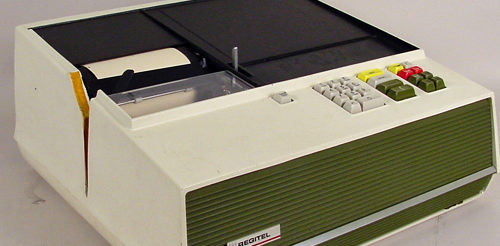When Technology Disrupts the Vibe | Lemelson Center for the Study of Invention and Innovation

As any one of my good friends will tell you, I love talking about my experience working in the food industry. From the time I was legally eligible to work though my early years as an undergrad at the University of Maryland, College Park (go Terps!), I was a self-proclaimed “renaissance worker” at a popular bagel shop chain. I could do it all—take orders, make any order on the menu from memory, operate the cash register, train new employees, bake bagels, prep food, wash dishes, take inventory, and schedule deliveries.
What I loved the most about the bagel shop was how “old school” it felt—we would handwrite orders on a kitchen order ticket (a two-part, carbonless paper form, with the top sheet going to the food line and the bottom one to the cashier) and stick them up on the food line. Customers could watch through the glass as line cooks read the handwritten orders and made their food. There was usually a pleasant feeling of personal interaction while writing down orders in front of the guest. It took a few minutes, and sure, on a busy Sunday morning we would have long lines, but customers knew to expect a wait for fresh bagels from a shop where you could see the hard work employees were physically doing to complete orders. It felt romantic.
In 2010, our shop underwent major renovations. Our staff was introduced to the electronic LED screen point-of-sale (POS) systems that were installed on our countertops, taking up the space where our human order takers once stood, and above the food line, which was now facing away from our customers so that while making food our backs would be turned to them. The POS was certainly not a new invention in 2010—as NMAH curator Peggy Kidwell writes on the museum’s website, “James J. Ritty, a pub owner from Dayton, Ohio, reportedly saw a counter used to count the revolutions of the propeller of a ship on an Atlantic voyage in 1878. He thought that if one could count the revolutions of a machine part, one could count money coming into a business. On his return to Ohio, he enlisted the mechanical skills of his brother John to design and build what they dubbed a cash register. Their prototype machine had a large, clock-like face and a row of keys for entering amounts from 5 cents to 95 cents (by fives) and from $1 to $9. A mechanism inside the machine recorded total sales.”
The POS system installed in my bagel shop took advantage of later technological developments. As Kidwell points out, “By the early 1970s, improvements in lasers made possible new equipment for tracking merchandise. RCA developed an “automatic checkout stand” that was tried for several months in 1972 . . . IBM, NCR, and other manufacturers soon sold point-of-sale terminals combined with checkout scanners. These fed information about purchases into computer systems. They became common in grocery and department stores across the country, making it possible to keep closer tabs on stock while reducing the number, training time, and pay of clerks.”
Regitel cash register, about 1970, NMAH 2002.0091.01. The Regitel is an early point-of-sale (POS) electronic cash register. Such terminals capture information about sales for computer processing. The device was made by the American Regitel Corporation and installed as a part of a networked system in department stores across the nation. The networks communicated over telephone systems at 9600 baud, which was extremely fast for the time period. Smithsonian photo AHB2010r7393
Our leap into modernization had massive impacts on the bagel shop. Line cooks stopped communicating. Order takers quickly pressed buttons on a screen, sometimes without needing to make eye contact with the customer. Food orders piled up as cooks could not keep up with the speed of order taking. Color-coded wait times on screens in front of line cooks added to the stress (yellow meant that you were going to slow; red meant that you were taking too long). Since our food line was turned around in the renovation, customers could no longer see the faces of the line cooks but could instead see the screens changing from yellow to red, therefore knowing that they were waiting too long for their orders. The warm and inviting local bagel shop vibe evaporated overnight, and a cold feeling of corporate ownership took its place.
An example of a patented POS system. Figure 16 from US Patent 5,924,07, issued to David Beach, Donald Braden, Layton, Paul L. George, and Michael Meredith, for a “Computer Based System for Monitoring and Processing Data Collected at the Point of Sale of Goods and Services,” 1999. Courtesy of US Patent and Trademark Office
In the years since I hung up my apron, I’ve occasionally visited my beloved bagel chain and watched as the employees operate the POS with ease. I understand how the innovations in electronic cash registers and POS terminals have been tremendously helpful to business operations by speeding up transactions and storing important information for inventory and employee and customer management. I know that the bagel chain would have failed if it chose not to switch to an electronic POS. Still, I can’t help but feel nostalgic for the times when handwriting orders felt like an homage to the past—and when fast food was just a little bit slower.
Sources:
Beach, David, Donald Braden, Layton, Paul L. George, and Michael Meredith, Computer Based System for Monitoring and Processing Data Collected at the Point of Sale of Goods and Services. US Patent 5,924,07, filed December 29, 1995, and issued July 13, 1999. Accessed 21 February 2020, https://patentimages.storage.googleapis.com/ab/8c/3c/cd698e4db8bb19/US5924077.pdf.
Kidwell, Peggy A., “Cash and Credit Registers,” National Museum of American History, accessed 21 February 2020, https://americanhistory.si.edu/collections/object-groups/cash-and-credit-registers.
Kidwell, Peggy A., “Regitel Cash Register / Point-of-Sale Terminal, National Museum of American History, accessed 21 February 2020, https://americanhistory.si.edu/collections/search/object/nmah_906024.
